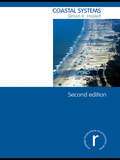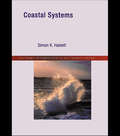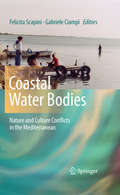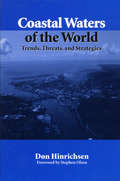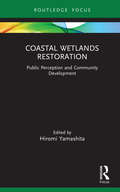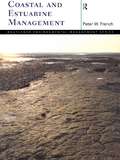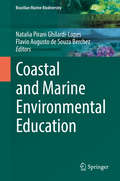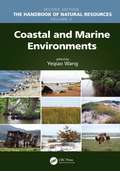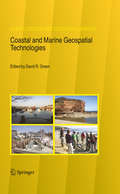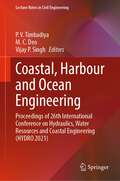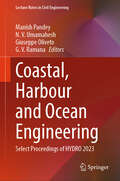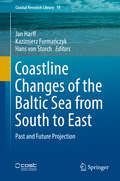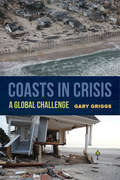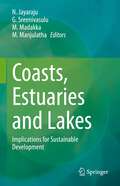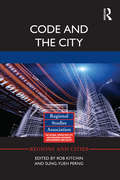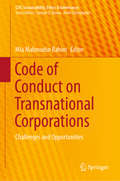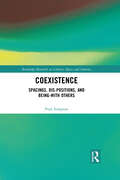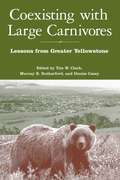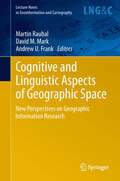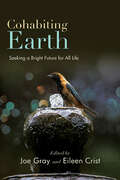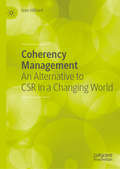- Table View
- List View
Coastal Systems
by Simon HaslettThe coast represents the crossroads between the oceans, land and atmosphere, and all three contribute to the physical and ecological evolution of coastlines. Coasts are dynamic systems, with identifiable inputs and outputs of energy and material. Changes to input force coasts to respond, often in dramatic ways as attested by the impacts of the Indian Ocean tsunami in 2004, the landfall of Hurricane Katrina along the Gulf Coast of the USA in 2005, and the steady rise of global warming driven sea-level. More than half the world’s human population lives at the coast, and here people often come into conflict with natural coastal processes. Research continues to unravel the relationship between coastal processes and society, so that we may better appreciate, understand, manage and live safely within this unique global environment. Coastal Systems offers a concise introduction to the processes, landforms, ecosystems and management of this important global environment. New to the second edition is a greater emphasis on the role of high-energy events, such as storms and tsunamis, which have manifested themselves with catastrophic effects in recent years. There is also a new concluding chapter, and updated guides to the ever-growing coastal literature. Each chapter is illustrated and furnished with topical case studies from around the world. Introductory chapters establish the importance of coasts, and explain how they are studied within a systems framework. Subsequent chapters explore the role of waves, tides, rivers and sea-level change in coastal evolution. Students will benefit from summary points, themed boxes, engaging discussion questions and new graded annotated guides to further reading at the end of each chapter. Additionally, a comprehensive glossary of technical terms and an extensive bibliography are provided. The book is highly illustrated with diagrams and original plates. The comprehensive balance of illustrations and academic thought provides a well balanced view between the role of coastal catastrophes and gradual processes, also examining the impact humans and society have and continue to have on the coastal environment.
Coastal Systems (Routledge Introductions to Environment: Environmental Science)
by Simon HaslettCoastal Systems offers a concise introduction to the processes, landforms, ecosystems, and management of coasts. Each chapter is illustrated and includes topical case studies from around the world such as:* Tsunami's in Papua New Guinea* cliff collapse in Southern England* the Great Barrier Reef* the Indian 'Super Cyclone' of 1999* the impact of development in the Florida Keys.Introductory chapters establish the importance of coasts and explain how they are studied within a system framework. Subsequent chapters explore the role of waves, rivers and sea level changes in coastal evolution. The final chapter reviews the human pressures and management of coastal systems.
Coastal Water Bodies: Nature and Culture Conflicts in the Mediterranean
by Felicita Scapini Gabriele CiampiAddressing the links between science and the real world with a sound scientific baseline, Coastal Water Bodies targets researchers of various disciplines whose interest lies in the integrated sustainable management of coastal water bodies. The main topic of this book is not the ecology according to its accepted meaning, but rather the 'places and people' concerned - the coastal zones of the Mediterranean that are rich in ecological value and the local people who survive thanks to these environmental resources. Integration is the joint consideration of different aspects of water uses and values, and new ways of understanding and managing conflicts around water use are needed if people are to benefit from integration. Sustainability of the ecological and socioeconomic environments requires a climate in which conflicts, if they need to exist, are properly managed in a non-destructive manner.
Coastal Waters of the World: Trends, Threats, and Strategies
by Don Hinrichsen Stephen OlsenNearly 60 percent of the world's population lives and works within 100 miles of a coast, and even those who don't are connected to the world's oceans through an intricate drainage of rivers and streams. Ultimately the whole of humankind is coastal. Coastal Waters of the World is a comprehensive reference source on the state of the world's coastal areas. It focuses on the tremendous pressures facing coastal areas and the management systems and strategies needed to cope with them. Don Hinrichsen explores the origins and implications of three related issues: the overwhelming threats to our coastal resources and seas from population and pollution; the destruction of critical resources through unsustainable economic activity; and the inability of governments to craft and implement rational coastal management plans. Introductory chapters present a concise summary of our coastal problems, including coastal habitat degradation and the fisheries crisis, along with a discussion of better management options. Three case studies of successful coastal governance focus on some of the problems and bring to life potential solutions. Following that are regional profiles that provide detailed information on the main population, resource, and management challenges facing each of the world's thirteen major coastal waters and seas. The book ends with a realistic and practical agenda for action that can be implemented immediately. Safeguarding these complex, interlinked ecosystems is humanity's most challenging management job. Coastal Waters of the World will help raise our awareness of coastal area concerns and provide a constructive contribution to the ongoing debate over how to manage these ever-changing areas, both for ourselves and for future generations. It will serve as a valuable reference tool and an up-to-date resource for policymakers, management specialists, and students interested in sustainable coastal governance.
Coastal Wetlands Restoration: Public Perception and Community Development (Routledge Focus on Environment and Sustainability)
by Hiromi YamashitaThis book examines a wide range of innovative approaches for coastal wetlands restoration and explains how we should use both academic research and practitioners’ findings to influence learning, practice, policy and social change. For conservationists, tidal flats and coastal wetlands are regarded as among the most important areas to conserve for the health of the entire oceanic environment. As the number of restoration projects all over the world increases, this book provides a unique assessment of coastal wetland restorations by examining existing community perceptions and by drawing on the knowledge and expertise of both academics and practitioners. Based on a four-year sociological study across three different cultural settings – England, Japan and Malaysia – the book investigates how citizens perceive the existing environment; how they discuss the risks and benefits of restoration projects; how perceptions change over time; and how governmental and non-governmental organisations work with the various community perceptions on the ground. By comparing and contrasting the results from these three countries, the book offers guidance for future conservation and restoration activities, with a specific view to working with local citizens to avoid conflict and obtain long-term investment. This book will be of great interest to students and scholars of coastal restoration, wetland conservation and citizen science, as well as environmental sociology and environmental management more broadly. It will also be of use to practitioners and policymakers involved in environmental restoration projects.
Coastal World Heritage Sites (Coastal Research Library #28)
by Vanda Claudino-SalesThis book presents the natural, environmental and scenic richness of the world’s coastal and marine areas classified by UNESCO as “Natural World Heritage Sites”. Representing well-preserved areas of exceptional significance to the planet and to humankind, they include a total of 49 marine sites, formed by reefs, atolls and gulfs, and 35 coastal sites in all oceans and all continents with exception of Antarctica. They are being protected and preserved from most degrading uses for future generations as an important legacy from the past. Exploring their richness, this book analyzes and explains these sites in a clear, understandable, scientific way, and is of interest to all who work in or care about the geosciences, environmental sciences and biosciences.
Coastal and Estuarine Management (Routledge Environmental Management)
by Peter FrenchThe coast cannot be left to nature to determine its fate. Wealth, property, economic interests, recreation, tourism and wildlife are all threatened. Coasts are an administrative battle ground and one of the most important and widely examined topics in environmental management.Coastal and Estuarine Management examines the issues surrounding the human use and abuse of estuarine and coastal environments. Emphasising the importance and significance of this natural resource, the uses and conflicts which occur and the results of human activity, this book explains the ways in which conservation and management policies and practices can protect this productive and diverse ecosystem.Examples and real-life case studies illustrate the effect of human intervention, both from an historic and contemporary perspective. Exposing the environmental consequences of estuarine pollution, Peter French highlights the need for management strategies to promote a sustainable development ethic for estuaries.
Coastal and Marine Environmental Education (Brazilian Marine Biodiversity)
by Natalia Pirani Ghilardi-Lopes Flavio Augusto BerchezThis book provides a broad overview of how the promotion of ocean and coastal literacy is being planned, applied and evaluated in Brazil, a country of continental dimensions with a great diversity of cultural, educational and social realities. It discusses a range of target groups, from children to adults; formal and informal strategies; and various promoting players, such as groups/institutions. Researchers representing Brazilian academic institutions and NGOs share their environmental education (EE) experiences in Brazil and describe the main concerns regarding the marine and coastal environments as well as how they are addressing these concerns in their EE projects. This book is of interest to anyone who is looking for ways of designing and implementing EE activities with a robust theoretical background in different socio-cultural scenarios.
Coastal and Marine Environments
by Yeqiao WangAuthored by world-class scientists and scholars, The Handbook of Natural Resources, Second Edition, is an excellent reference for understanding the consequences of changing natural resources to the degradation of ecological integrity and the sustainability of life. Based on the content of the bestselling and CHOICE-awarded Encyclopedia of Natural Resources, this new edition demonstrates the major challenges that the society is facing for the sustainability of all well-being on the planet Earth. The experience, evidence, methods, and models used in studying natural resources are presented in six stand-alone volumes, arranged along the main systems of land, water, and air. It reviews state-of-the-art knowledge, highlights advances made in different areas, and provides guidance for the appropriate use of remote sensing and geospatial data with field-based measurements in the study of natural resources. Volume 5, Coastal and Marine Environments, discusses marine and coastal ecosystems, their biodiversity, conservation, and integrated marine management plans. It provides fundamental information on coastal and estuarine systems and includes discussions on coastal erosion and shoreline change, natural disasters, evaporation and energy balance, fisheries and marine resource management, and more. New in this edition are discussions on sea level rise, renewable energy, coral reef restoration, fishery resource economics, and coastal remote sensing. This volume demonstrates the key processes, methods, and models used through many case studies from around the world. Written in an easy-to-reference manner, The Handbook of Natural Resources, Second Edition, as individual volumes or as a complete set, is an essential reading for anyone looking for a deeper understanding of the science and management of natural resources. Public and private libraries, educational and research institutions, scientists, scholars, and resource managers will benefit enormously from this set. Individual volumes and chapters can also be used in a wide variety of both graduate and undergraduate courses in environmental science and natural science at different levels and disciplines, such as biology, geography, earth system science, and ecology.
Coastal and Marine Geospatial Technologies (Coastal Systems and Continental Margins #13)
by D. R. GreenThis international collection of papers represents a selected and up-to-date overview of some of the main areas of research into the application of the geospatial technologies, including geographical information systems (GIS), remote sensing, digital mapping, global positioning systems (GPS), databases, Internet technology, and mobile field-data collection and mapping, to coastal and marine environments around the World. Aimed at the researcher, editor, practitioner and student, this volume seeks to expand the available literature in a rapidly expanding and evolving area, namely the coastal and marine environment. The book comes at a time when there is growing concern about global warming, climate change, and sea level rise, all of which will have an impact upon coastal areas. These geospatial technologies offer the possibility to gather unique environmental data to study the coast, to process the data into information, to visualise data and landscapes, to gather data in the field, and to involve stakeholders in coastal management amongst other things. Considerable potential now exists to raise awareness, to educate and to embrace these technologies as one way to promote greater knowledge and understanding of our marine and coastal environments.
Coastal, Harbour and Ocean Engineering: Proceedings of 26th International Conference on Hydraulics, Water Resources and Coastal Engineering (HYDRO 2021) (Lecture Notes in Civil Engineering #321)
by Vijay P. Singh P. V. Timbadiya M. C. DeoThis book comprises the proceedings of the 26th International Conference on Hydraulics, Water Resources and Coastal Engineering (HYDRO 2021) focusing on broad spectrum of emerging opportunities and challenges in the field of coastal, harbor and ocean engineering. It covers a range of topics, including, but not limited to, coastal disasters including tsunamis, cyclones and storm surges, sea level rise, coastal structures and oceanography, wave-structure interaction, etc. Presenting recent advances in the form of illustrations, tables, and text, it offers readers insights for their own research. In addition, the book addresses fundamental concepts and studies in the field of coastal, harbor and ocean engineering, making it a valuable resource for both beginners and researchers wanting to further their understanding of hydraulics, water resources and coastal engineering.
Coastal, Harbour and Ocean Engineering: Select Proceedings of HYDRO 2023 (Lecture Notes in Civil Engineering #424)
by Manish Pandey Giuseppe Oliveto G. V. Ramana N. V. UmamaheshThis book comprises proceedings of the 28th International Conference on Hydraulics, Water Resources, River and Coastal Engineering (HYDRO 2023). It focuses on emerging opportunities and challenges in the field of coastal, harbor and ocean engineering. The book covers a range of topics including, but not limited to, coastal disasters including tsunamis, cyclones and storm surges, sea level rise, coastal structures and oceanography, wave-structure interaction. The book presents these topics in the form of illustrations and tables, thereby providing the readers with an in-depth insight into the recent research. It also addresses fundamental concepts and studies in the field of coastal, harbor and ocean engineering, making it a valuable resource for both researchers and professionals working in the fields of hydraulics, water resources and coastal engineering.
Coastline Changes of the Baltic Sea from South to East: Past and Future Projection (Coastal Research Library #19)
by Hans Von Storch Jan Harff Kazimierz FurmańczykThe book discusses sea-level and coastline changes which are becoming increasingly important topics for the population living along the edge of the world's oceans and seas. These topics are of special importance where eustatic sea-level rise is superimposed by isostatic subsidence and storm induced coastal erosion. This is the case at the southern and eastern Baltic Sea coast: In the South, where glacio-isostatic subsidence enhances the effect of climate induced sea-level rise and strong storm effects cause a continuous retreat of the coast. At the eastern coast the glacio-isostatic uplift compensates eustatic sea-level rise, but storm induced waves cause permanent morphodynamic changes of the coastline. There is an increasing need for concepts for protection, for defense but also for the economic use of the different types of coastal zones. The elaboration of those management concepts can be facilitated through models that generate future projections of coastal developments in front of the modern climate change. The proposed anthology comprises results of the research project "Coastline Changes of the southern Baltic Sea - Past and future projection (CoPaF)" which was ran by a team of Estonian, German, and Polish geoscientists and coastal engineers from 2010 to 2013. As the southern and eastern Baltic serves as a natural laboratory for the investigation of coastal processes - the achievements of the project shall contribute not only to the solution of regional problems in Baltic coastal research and engineering, but, shall be regarded as a contributions to general foci of description, modelling and parameterization of coastal processes and morphodynamics.
Coastlines: At the Water's Edge
by Emily NathanA wanderlust-inspiring photography collection of the world&’s most stunning waterways and coastlines from the premier online curator of travel photography, Tiny Atlas Quarterly. From tropical beaches in Hawai&’i and icy fjords in Greenland to lush mangrove swamps in the Cuban Cayos and forested islands in Vietnam, coastlines and waterways are some of the world&’s most beloved places and most precious habitats. With hundreds of awe-inspiring photos from locations far and wide, Coastlines is a visual tour of these magical watery places and a treasure trove of curated travel information. Water lovers, beach bums, and armchair travelers will enjoy this tranquil exploration of the world&’s many vast and varied shores.
Coasts in Crisis: A Global Challenge
by Prof. Gary GriggsCoastal regions around the world have become increasingly crowded, intensively developed, and severely exploited. Hundreds of millions of people living in these low-lying areas are subject to short-term coastal hazards such as cyclones, hurricanes, and destruction due to El Niño, and are also exposed to the long-term threat of global sea-level rise. These massive concentrations of people expose often-fragile coastal environments to the runoff and pollution from municipal, industrial, and agricultural sources as well as the impacts of resource exploitation and a wide range of other human impacts. Can environmental impacts be reduced or mitigated and can coastal regions adapt to natural hazards? Coasts in Crisis is a comprehensive assessment of the impacts that the human population is having on the coastal zone globally and the diverse ways in which coastal hazards impact human settlement and development. Gary Griggs provides a concise overview of the individual hazards, risks, and issues threatening the coastal zone.
Coasts, Estuaries and Lakes: Implications for Sustainable Development
by N. Jayaraju G. Sreenivasulu M. Madakka M. ManjulathaThis volume discusses geological, biological and sustainability aspects of coastal, estuary and lake environments. It offers a comprehensive understanding of biotic, physico-chemical, sedimentological and socio-environmental factors associated with the sustainable development of these environments in areas vulnerable to climate change and other anthropogenic activities. The book is divided into several main sections, covering the geological and biological processes and dynamics of these environments, water quality and hydrological modeling, sediment characteristics, bio-indicators and ecological analysis, climate change impacts, geospatial applications, and sustainable development practices and scenarios. The book aims to be a useful resource for academics, scientists, coastal and marine practitioners, meteorologists, environmental consultants and computing experts working in the areas of earth and ocean sciences.
Code and the City (Regions and Cities)
by Rob Kitchin Sung-Yueh PerngSoftware has become essential to the functioning of cities. It is deeply embedded into the systems and infrastructure of the built environment and is entrenched in the management and governance of urban societies. Software-enabled technologies and services enhance the ways in which we understand and plan cities. It even has an effect on how we manage urban services and utilities. Code and the City explores the extent and depth of the ways in which software mediates how people work, consume, communication, travel and play. The reach of these systems is set to become even more pervasive through efforts to create smart cities: cities that employ ICTs to underpin and drive their economy and governance. Yet, despite the roll-out of software-enabled systems across all aspects of city life, the relationship between code and the city has barely been explored from a critical social science perspective. This collection of essays seeks to fill that gap, and offers an interdisciplinary examination of the relationship between software and contemporary urbanism. This book will be of interest to those researching or studying smart cities and urban infrastructure.
Code of Conduct on Transnational Corporations: Challenges and Opportunities (CSR, Sustainability, Ethics & Governance)
by Mia Mahmudur RahimThis book explores the challenges and opportunities presented by the formulation of a global code of conduct for transnational corporations. It assesses the current state of research on global regulations intended to enhance the social responsibility of transnational corporations, and provides a platform for future research. In particular the book examines frameworks and instruments for regulating social responsibility, reviews recent developments concerning the proposed UN Code of Conduct on Transnational Corporations, and provides insights into international civil society groups’ movements in pursuit of a code of conduct. In a separate chapter the book discusses theoretical issues in regulating transnational corporations, and investigates their legitimacy and behavioral dynamics. In closing, the book discusses alternatives to a global code of conduct, the impact of sovereign power in the era of globalization, “soft regulations,” and the feasibility and normative efficacy of enforcing regulations.
Code of Conduct on Transnational Corporations: Challenges and Opportunities (CSR, Sustainability, Ethics & Governance)
by Mia Mahmudur RahimThis book explores the challenges and opportunities presented by the formulation of a global code of conduct for transnational corporations. It assesses the current state of research on global regulations intended to enhance the social responsibility of transnational corporations, and provides a platform for future research. In particular the book examines frameworks and instruments for regulating social responsibility, reviews recent developments concerning the proposed UN Code of Conduct on Transnational Corporations, and provides insights into international civil society groups’ movements in pursuit of a code of conduct. In a separate chapter the book discusses theoretical issues in regulating transnational corporations, and investigates their legitimacy and behavioral dynamics. In closing, the book discusses alternatives to a global code of conduct, the impact of sovereign power in the era of globalization, “soft regulations,” and the feasibility and normative efficacy of enforcing regulations.
Coexistence: Spacings, Dis-positions, and Being-with Others (Routledge Research in Culture, Space and Identity)
by Paul SimpsonThis book aims to develop an account of living together with difference which recognises the tension that we are inescapably with others – both human and non-human – but at the same time are always differing from and with those with whom we find ourselves.A concern for coexistence and questions over how we might live together have been raised and approached from a host of conceptual starting points in recent times, including via calls for a rethinking of communism today, the articulation of forms of ‘cosmopolitics’ or ‘pluralism’, the re-figuring of understandings of ecology as dark or feminist, amongst others. This book responds to such questions of coexistence by developing what it calls a ‘co-existential analytic’. In doing so, this book introduces a range of post-phenomenological thought which offers means for thinking about such questions of living together with difference. The thought of Emanuel Levinas on the face of the other, Jean-Luc Nancy on being as being-with, Roberto Esposito on the munis, and Michel Henry on pathic auto-affection are introduced and critically reflected upon in terms of what they offer for thinking about such coexistence. Alongside these conceptual starting points, a series of encounters - with cinema, everyday life, politics, and literature - are used to animate and illustration the discussion. Ultimately, the book argues for a ‘spacing’ of subjectivities with that world and those encountered within it.This book is intended primarily for researchers and postgraduate students interested in questions of identity, difference, and subjectivity. It will be of interest to those in the fields of social and cultural geography, sociology, social theory, and cultural studies.
Coexisting with Large Carnivores: Lessons From Greater Yellowstone
by Murray Rutherford Denise Casey Tim ClarkAs in the rest of the United States, grizzly bears, wolves, and mountain lions in and around Yellowstone National Park were eliminated or reduced decades ago to very low numbers. In recent years, however, populations have begun to recover, leading to encounters between animals and people and, more significantly, to conflicts among people about what to do with these often controversial neighbors. Coexisting with Large Carnivores presents a close-up look at the socio-political context of large carnivores and their management in western Wyoming south of Yellowstone National Park, including the southern part of what is commonly recognized as the Greater Yellowstone Ecosystem. The book brings together researchers and others who have studied and worked in the region to help untangle some of the highly charged issues associated with large carnivores, their interactions with humans, and the politics that arise from those interactions. This volume argues that coexistence will be achieved only by a thorough understanding of the human populations involved, their values, attitudes, beliefs, and the institutions through which carnivores and humans are managed. Coexisting with Large Carnivores offers important insights into this complex, dynamic issue and provides a unique overview of issues and strategies for managers, researchers, government officials, ranchers, and everyone else concerned about the management and conservation of large carnivores and the people who live nearby.
Coffee and Community
by Sarah LyonWe are told that simply by sipping our morning cup of organic, fair-trade coffee we are encouraging environmentally friendly agricultural methods, community development, fair prices, and shortened commodity chains. But what is the reality for producers, intermediaries, and consumers? This ethnographic analysis of fair-trade coffee analyzes the collective action and combined efforts of fair-trade network participants to construct a new economic reality. Focusing on La Voz Que Clama en el Desierto-a cooperative in San Juan la Laguna, Guatemala-and its relationships with coffee roasters, importers, and certifiers in the United States, Coffee and Community argues that while fair trade does benefit small coffee-farming communities, it is more flawed than advocates and scholars have acknowledged. However, through detailed ethnographic fieldwork with the farmers and by following the product, fair trade can be understood and modified to be more equitable. This book will be of interest to students and academics in anthropology, ethnology, Latin American studies, and labor studies, as well as economists, social scientists, policy makers, fair-trade advocates, and anyone interested in globalization and the realities of fair trade.
Cognitive and Linguistic Aspects of Geographic Space: New Perspectives on Geographic Information Research (Lecture Notes in Geoinformation and Cartography #63)
by David M Mark Martin Raubal Andrew U. Frank20 years ago, from July 8 to 20, 1990, 60 researchers gathered for two weeks at Castillo-Palacio Magalia in Las Navas del Marques (Avila Province, Spain) to discuss cognitive and linguistic aspects of geographic space. This meeting was the start of successful research on cognitive issues in geographic information science, produced an edited book (D. M. Mark and A. U. Frank, Eds., 1991, Cognitive and Linguistic Aspects of Geographic Space. NATO ASI Series D: Behavioural and Social Sciences 63. Kluwer, Dordrecht/Boston/London), and led to a biannual conference (COSIT), a refereed journal (Spatial Cognition and Computation), and a substantial and still growing research community. It appeared worthwhile to assess the achievements and to reconsider the research challenges twenty years later. What has changed in the age of computational ontologies and cyber-infrastructures? Consider that 1990 the web was only about to emerge and the very first laptops had just appeared! The 2010 meeting brought together many of the original participants, but was also open to others, and invited contributions from all who are researching these topics. Early-career scientists, engineers, and humanists working at the intersection of cognitive science and geographic information science were invited to help with the re-assessment of research needs and approaches. The meeting was very successful and compared the research agenda laid out in the 1990 book with achievements over the past twenty years and then turned to the future: What are the challenges today? What are worthwhile goals for basic research? What can be achieved in the next 20 years? What are the lessons learned? This edited book will assess the current state of the field through chapters by participants in the 1990 and 2010 meetings and will also document an interdisciplinary research agenda for the future.
Cohabiting Earth: Seeking a Bright Future for All Life
by Joe Gray; Eileen CristThe eco-catastrophes that we are witnessing today starkly demonstrate how the interests of the Earth's currently dominant species are in lockstep with those of nature's wider whole. Simply stated, humans and the more-than-human world have a shared fate. Just as humanity's unrestrained overreach in the ecosphere is driving a mass extinction event and causing the devastation of lifeforms and places, so it is also jeopardizing the prospect of a human future worth living. There is no "humans versus nature" tradeoff: the wellbeing of both is inseparably entwined. Solutions to the shared predicament of all Earth's beings will thus necessarily be those that strive for harmony between human presence and the rest of nature. This applies to the philosophy we adopt for agriculture, the ways in which human economies operate, our patterns of consumption, and numerous other intertwined threads of our existence. This anthology argues that harmony between humanity and our home planet must be built on the pillars of restraint, respect, and reverence.
Coherency Management: An Alternative to CSR in a Changing World
by Ivan HilliardThis book presents a new approach to corporate responsibility based on the concept of coherency, permitting better understanding and management of the conflicting forces that strive to create value across the stakeholder spectrum. In doing so, it provides an alternative to the limited and ineffective role currently played by Corporate Social Responsibility (CSR), and offers an approach more in line with the needs of a sustainable society. Hilliard introduces several new concepts in management philosophy and presents an innovative and original framework for managing organizational responsibilities in a coherent manner.
